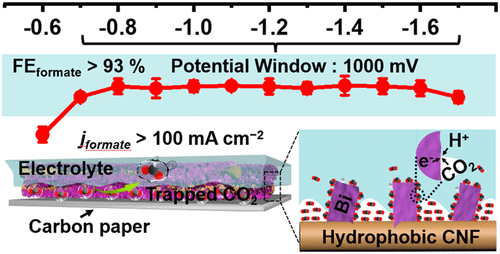Our official English website, www.x-mol.net, welcomes your
feedback! (Note: you will need to create a separate account there.)
Bi2O3 Nanosheets Grown on Carbon Nanofiber with Inherent Hydrophobicity for High-Performance CO2 Electroreduction in a Wide Potential Window
ACS Nano ( IF 15.8 ) Pub Date : 2021-10-21 , DOI: 10.1021/acsnano.1c05737 Shao-Qing Liu 1 , Ehsan Shahini 2 , Min-Rui Gao 1 , Lu Gong 1 , Peng-Fei Sui 1 , Tian Tang 2 , Hongbo Zeng 1 , Jing-Li Luo 1
ACS Nano ( IF 15.8 ) Pub Date : 2021-10-21 , DOI: 10.1021/acsnano.1c05737 Shao-Qing Liu 1 , Ehsan Shahini 2 , Min-Rui Gao 1 , Lu Gong 1 , Peng-Fei Sui 1 , Tian Tang 2 , Hongbo Zeng 1 , Jing-Li Luo 1
Affiliation

|
The ever-increasing concern for adverse climate changes has propelled worldwide research on the reduction of CO2 emission. In this regard, CO2 electroreduction (CER) to formate is one of the promising approaches to converting CO2 to a useful product. However, to achieve a high production rate of formate, the existing catalysts for CER fall short of expectation in maintaining the high formate selectivity and activity over a wide potential window. Through this study, we report that Bi2O3 nanosheets (NSs) grown on carbon nanofiber (CNF) with inherent hydrophobicity achieve a peak formate current density of 102.1 mA cm–2 and high formate Faradaic efficiency of >93% over a very wide potential window of 1000 mV. To the best of our knowledge, this outperforms all the relevant achievements reported so far. In addition, the Bi2O3 NSs on CNF demonstrate a good antiflooding capability when operating in a flow cell system and can deliver a current density of 300 mA cm–2. Molecular dynamics simulations indicate that the hydrophobic carbon surface can repel water molecules to form a robust solid–liquid–gas triple-phase boundary and a concentrated CO2 layer; both can boost CER activity with the local high concentration of CO2 and through inhibiting the hydrogen evolution reaction (HER) by reducing proton contacts. This water-repelling effect also increases the local pH at the catalyst surface, thus inhibiting HER further. More significantly, the concept and methodology of this hydrophobic engineering could be broadly applicable to other formate-producing materials from CER.
中文翻译:

在具有固有疏水性的碳纳米纤维上生长的 Bi2O3 纳米片可在宽电位窗口中进行高性能 CO2 电还原
对不利气候变化的日益关注推动了全球对减少 CO 2排放的研究。在这方面,将 CO 2电还原 (CER) 还原为甲酸盐是将 CO 2转化为有用产品的有前途的方法之一。然而,为了实现高甲酸盐的产率,现有的 CER 催化剂在保持高甲酸盐选择性和活性方面达不到预期。通过这项研究,我们报告了在具有固有疏水性的碳纳米纤维 (CNF) 上生长的Bi 2 O 3纳米片 (NSs) 达到了 102.1 mA cm –2的峰值甲酸电流密度在 1000 mV 的非常宽的电位窗口内,甲酸法拉第效率 >93%。据我们所知,这超过了迄今为止报告的所有相关成就。此外,CNF 上的 Bi 2 O 3 NSs 在流通池系统中运行时表现出良好的抗溢流能力,可提供 300 mA cm –2的电流密度。分子动力学模拟表明,疏水性碳表面可以排斥水分子,形成坚固的固-液-气三相边界和浓缩的CO 2层;两者都可以通过局部高浓度的 CO 2提高 CER 活性并通过减少质子接触来抑制析氢反应 (HER)。这种防水作用还增加了催化剂表面的局部 pH 值,从而进一步抑制了 HER。更重要的是,这种疏水工程的概念和方法可以广泛适用于来自 CER 的其他甲酸盐生产材料。
更新日期:2021-11-23
中文翻译:

在具有固有疏水性的碳纳米纤维上生长的 Bi2O3 纳米片可在宽电位窗口中进行高性能 CO2 电还原
对不利气候变化的日益关注推动了全球对减少 CO 2排放的研究。在这方面,将 CO 2电还原 (CER) 还原为甲酸盐是将 CO 2转化为有用产品的有前途的方法之一。然而,为了实现高甲酸盐的产率,现有的 CER 催化剂在保持高甲酸盐选择性和活性方面达不到预期。通过这项研究,我们报告了在具有固有疏水性的碳纳米纤维 (CNF) 上生长的Bi 2 O 3纳米片 (NSs) 达到了 102.1 mA cm –2的峰值甲酸电流密度在 1000 mV 的非常宽的电位窗口内,甲酸法拉第效率 >93%。据我们所知,这超过了迄今为止报告的所有相关成就。此外,CNF 上的 Bi 2 O 3 NSs 在流通池系统中运行时表现出良好的抗溢流能力,可提供 300 mA cm –2的电流密度。分子动力学模拟表明,疏水性碳表面可以排斥水分子,形成坚固的固-液-气三相边界和浓缩的CO 2层;两者都可以通过局部高浓度的 CO 2提高 CER 活性并通过减少质子接触来抑制析氢反应 (HER)。这种防水作用还增加了催化剂表面的局部 pH 值,从而进一步抑制了 HER。更重要的是,这种疏水工程的概念和方法可以广泛适用于来自 CER 的其他甲酸盐生产材料。













































 京公网安备 11010802027423号
京公网安备 11010802027423号